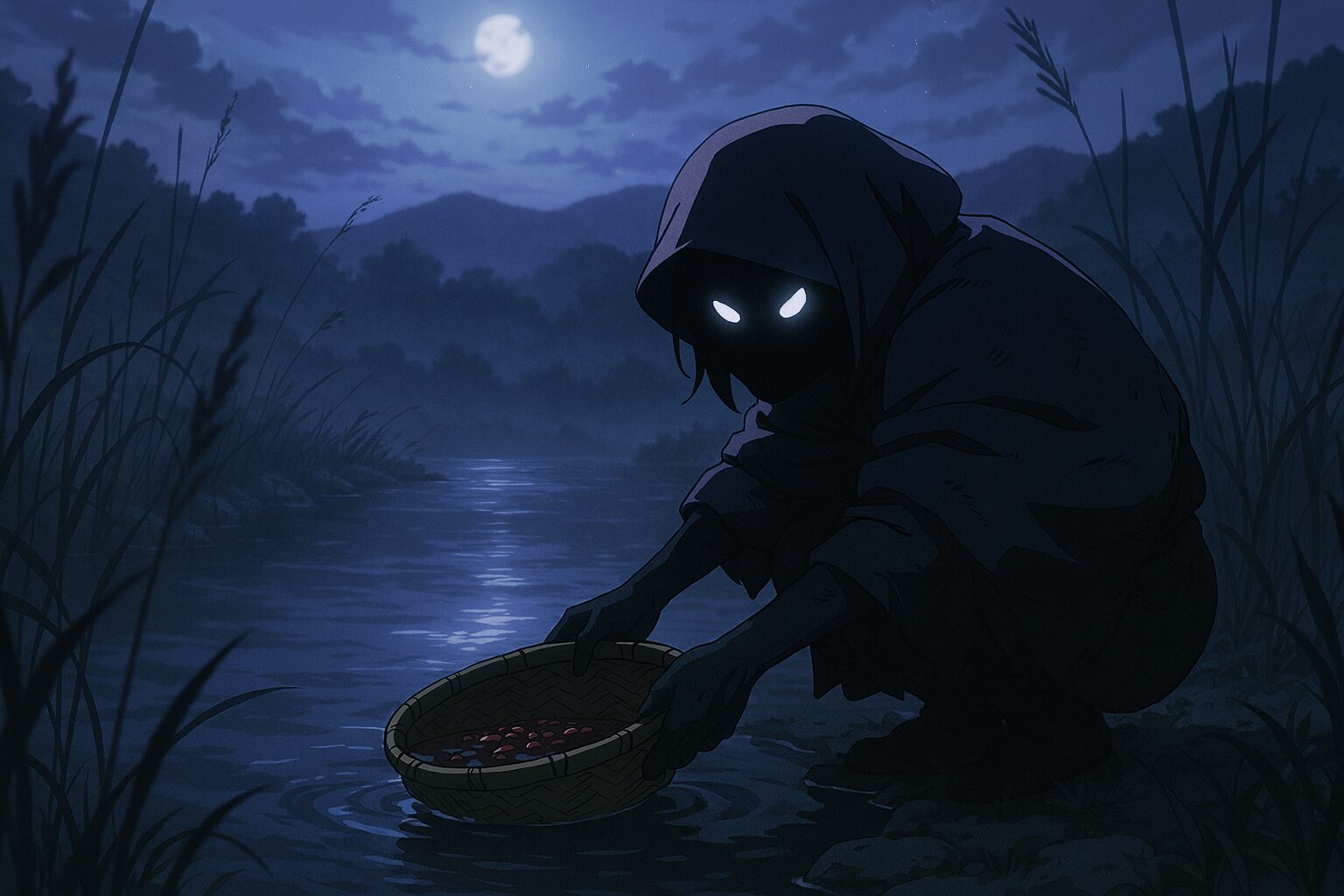In Japan, twilight is known as “Ouma-ga-toki” (the time when disasters or spirits manifest), a moment when the boundary between our world and the spirit world blurs. If you hear a strange sound coming from the river in that dim light, you must never approach it. Today, I will introduce the story of “Azukitogi” (also known as Azukiarai), a Yokai (spirit) that is feared yet strangely beloved across Japan.
The Story: Shoki, Shoki… Do Not Listen to That Sound
Long ago, a traveler was passing through a mountain village in a remote region. It was late autumn, and a chilly wind was shaking the trees, making a dry, rustling sound.
The traveler was in a hurry. Rumors said that once the sun set, these mountain passes would be enveloped in pitch-black darkness, prowled by wolves and bandits. However, as if mocking his haste, the sun sank behind the western mountains, and the surroundings rapidly turned into a deep blue-black darkness.
“This is trouble. I wish there were a small shrine or shelter where I could rest,” he muttered.
Just as the traveler was about to cross an old bridge over a small river, it happened.
Shoki, Shoki, Shoki…
From the darkness at the foot of the river, where reeds grew thick, a strange sound emerged. It was a rhythmic, wet sound, like someone scrubbing grains, such as Azuki beans, in a bamboo basket.
Who would be washing rice or beans in the river at this time of night? The time for the village women to cook was long past. The traveler stopped and strained his ears.
Shoki, Shoki, Zaza… Shoki, Shoki…
The sound did not stop. With a mixture of curiosity and fear, the traveler leaned over the railing of the bridge and peered into the darkness downstream. Then, carried by the wind, an eerie singing voice accompanied the sound.
“Azuki togou ka, hito totte kuou ka… Shoki, Shoki.”
(Shall I wash my red beans, or shall I catch and eat a human… scrub, scrub.)
A chill ran down the traveler’s spine. The voice was low, raspy, and certainly not human.
(It’s a Yokai! It’s the Azukitogi!)
The traveler remembered the folktales he had heard. They said if you get distracted by this sound and approach the river, you will be dragged into the water. “I must run,” he thought. In that instant, his foot kicked a small pebble, and a sharp “clack” echoed through the silence.
Immediately, the scrubbing sound and the singing stopped abruptly. A tense silence followed. The next moment—
SPLASH!
A massive splash erupted as something dived into the river. The traveler screamed and scrambled away, running for his life.
Eventually, he barely made it to the neighboring village. When he told the villagers his story, they laughed and said, “You were lucky. They say seeing the Azukitogi can bring good fortune or disaster, but it’s best you weren’t eaten.”
The next morning, when the traveler fearfully returned to the bridge, no one was on the riverbank. However, on a wet rock, it is said that a single red Azuki bean was left behind.
Analysis: A Monster of Fear and Charm
“Azukitogi” (or Azukiarai) is very famous among Japanese Yokai, but there are actually very few stories where it directly harms humans. Although it sings terrifying threats like “Shall I catch and eat a human?”, in most legends, it is timid and dives into the water to escape as soon as a person approaches.
This reveals a specific aspect of Japanese Yokai: “Phenomena of Sound.” In ancient Japan, nature at night was complete darkness. The sound of a flowing river or rustling leaves was likely transformed by human imagination into the sound of “washing beans.” This Yokai is an illusion born from the awe of nature, yet depicted as a somewhat cowardly and human-like character.
Cultural Insight: Why “Azuki” Beans?
To deeply understand this story, one must know the role of “Azuki” in Japanese culture.
- Red for Warding off Evil: Since ancient times in Japan, the color “red” has been believed to repel evil spirits and protect against misfortune. Red Azuki beans are considered a food with spiritual power.
- Food for Celebration: “Sekihan” (sticky rice steamed with Azuki beans) is always served at celebratory occasions.
In other words, the situation of a monster washing “sacred beans that ward off evil” is contradictory and mysterious. By combining a “sacred act” with the “creepiness of a Yokai,” it represents the other world lurking behind everyday life. Also, the sound of washing beans (Shoki Shoki) was a symbol of daily life deeply rooted in the Japanese lifestyle of that era.
What Would You Do?
If you were alone by a river at night and heard the sound “Shoki, Shoki,” what would you do?
Would you succumb to curiosity and take a peek? Or would you cover your ears and run away?
The Azukitogi might be testing the “morbid curiosity” in your heart. The next time you walk in nature, try taking off your headphones and listening closely. You might just hear that song.
References & Links:
Japanese Folktale Series Category (Kiri53.com)
JNTO (Japan National Tourism Organization)
【日本の昔話】あずきとぎ:川辺に響く不気味な音の正体
日本の夕暮れは、世界と異界の境界線が曖昧になる時間、「逢魔が時(おうまがとき)」と呼ばれます。その薄暗がりの中で、川の方から奇妙な音が聞こえてきたら、決して近づいてはいけません。今回は、日本各地で目撃され、恐れられながらもどこか愛嬌のある妖怪「あずきとぎ(または小豆洗い)」の物語を紹介します。
物語:ショキ、ショキ、その音を聞いてはいけない
昔々、ある地方の山深い村に、ひとりの旅人が通りかかりました。季節は秋の終わり、肌寒い風が木々を揺らし、カサカサと乾いた音を立てています。
旅人は先を急いでいました。日が落ちると、この辺りの峠道は漆黒の闇に包まれ、狼や盗賊が出るという噂があったからです。しかし、足早に歩く彼をあざ笑うかのように、太陽は西の山へと沈み、辺りは急速に青黒い闇へと変わっていきました。
「困ったな。どこか休める堂でもあればいいのだが」
旅人が小さな川にかかる古い橋を渡ろうとした、その時です。
ショキ、ショキ、ショキ……。
川のたもと、葦(あし)が生い茂る暗がりから、奇妙な音が聞こえてきました。それはまるで、ザルの中で小豆のような穀物を研いでいるような、リズミカルで湿った音でした。
こんな夜更けに、誰が川で米や豆を洗っているのでしょう? 里の女たちが炊事をする時間はとうに過ぎています。旅人は足を止め、耳を澄ませました。
ショキ、ショキ、ザザーッ。ショキ、ショキ……。
音は止みません。好奇心と恐怖が入り混じる中、旅人は橋の欄干から身を乗り出し、川下の暗闇を覗き込みました。すると、音に合わせて、不気味な歌声が風に乗って聞こえてきたのです。
「小豆とごうか、人とって食おうか……ショキ、ショキ」
旅人の背筋に冷たいものが走りました。「小豆を洗おうか、それとも人間を捕まえて食ってしまおうか」と歌っているのです。声は低く、しわがれており、とても人間のものとは思えません。
(妖怪だ! あずきとぎだ!)
旅人は噂に聞いていた妖怪の話を思い出しました。この音に気を取られて川に近づくと、水の中に引きずり込まれてしまうというのです。逃げなければならない。そう思った瞬間、足元の小石を蹴ってしまい、「カツン」という音が響きました。
とたんに、ショキショキという音と歌声がピタリと止まりました。張り詰めた静寂。次の瞬間。
ザッパァーーーン!
大きな水音がして、何かが川の中へと飛び込みました。旅人は悲鳴を上げ、転がるようにしてその場を逃げ出しました。
結局、旅人は命からがら隣村へたどり着きました。村人にその話をすると、彼らは笑って言いました。「それは運が良かった。あずきとぎは、姿を見ると縁起が良いとも、逆に災難が降るとも言われる。だが、食われなくて何よりだったな」と。
翌朝、旅人が恐る恐るその橋に戻ってみると、川岸には誰もいませんでした。ただ、濡れた岩の上に、赤い小豆が一粒だけ、ポツンと残されていたといいます。
考察:恐怖と愛嬌の二面性を持つ妖怪
「あずきとぎ(小豆洗い)」は、日本の妖怪の中でも非常に有名ですが、実際に人間に直接的な危害を加える話は実は多くありません。「人取って食おうか」と恐ろしいことを口にしますが、多くの伝承では、人が近づくと驚いて水に飛び込んで逃げてしまいます。
ここには、日本の妖怪特有の「音の怪異」という側面が見て取れます。かつての日本では、夜の自然は完全な闇でした。川のせせらぎや、木の葉が擦れる音が、人々の想像力によって「小豆を洗う音」に変換されたのでしょう。この妖怪は、自然への畏怖が生み出した幻影でありながら、どこか臆病で人間臭いキャラクターとして描かれています。
日本文化の視点:なぜ「小豆(Azuki)」なのか?
この物語を深く理解するためには、日本文化における「小豆(Azuki)」の役割を知る必要があります。
- 魔除けの赤: 古来より日本では、「赤色」は邪気を払い、災いから身を守る色とされてきました。赤い色をした小豆は、霊的な力を持つ特別な食材です。
- ハレの日の食べ物: 小豆を使った「赤飯(Sekihan)」は、お祝い事の席で必ず振る舞われます。
つまり、妖怪が「神聖で魔除けの効果がある小豆」を洗っているという状況自体が、非常に矛盾しており、ミステリアスです。これは、「神聖な行い」と「妖怪の不気味さ」を組み合わせることで、日常の裏側に潜む異界を表現していると考えられます。また、小豆を洗う音(ショキショキ)は、当時の日本の生活に根付いた、日常的な生活音の象徴でもありました。
あなたならどうしますか?
もしあなたが、誰もいない夜の川辺で「ショキ、ショキ」という音を聞いたらどうしますか?
好奇心に負けて覗き込みますか? それとも、耳を塞いで走り去りますか?
あずきとぎは、あなたの心の隙間にある「怖いもの見たさ」を試しているのかもしれません。次に自然の中を歩くときは、イヤホンを外して耳を澄ませてみてください。もしかすると、あの歌が聞こえてくるかもしれません。
参考文献・リンク:
Japanese Folktale Series Category (Kiri53.com)
国際日本文化研究センター (Nichibun) – 妖怪データベース



コメント